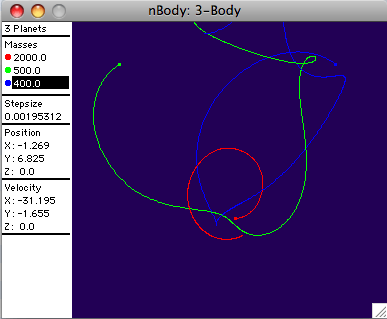Last update=28 January, 2009


Above is a typical window containing an n-Body System. An n-Body System consists of n >= 2 planets, interacting via Newtonian gravity. Initial positions, velocities and masses of the planets must be assigned. The gravitational constant is taken equal to 1. When the space bar is pressed G&G animates the motion until two of the planets either reach a minimum or maximum distance. G&G shows the traces of the motion, ie, their orbits. Nearly all n-body systems with three or more planets exhibit chaotic behaviour. Eventually the planets usually fly off in different directions. The exception is when one of the planets has a large mass which dominates all the others.
The view shown is a projection onto the xy-plane of a 3D motion. The view can be rotated via the numeric keypad, as for sphere maps and polyhedra. When the view is rotated, or if the window is resized, the current traces of the orbits are erased.
To adjust the positions, velocities, or masses of the planets, click on a mass in the window, and use the up and down arrow keys to adjust the corresponding values.

